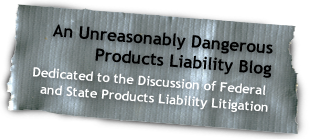Late last week, the New Jersey Supreme Court introduced a revised standard for the admissibility of eyewitness identifications in criminal prosecutions. State v. Henderson, — A. 3d —-, 2011 WL 3715028 (N.J. Aug. 24, 2011). We here at Abnormal Use have not forgotten that we are products liability blawg. But the New Jersey court’s opinion deserves our consideration because it shakes the bedrock of the American judicial system.
Science occupies a strange place in American culture. By and large, Americans love science when the fruit of scientific endeavors yields technology that accommodates our lives. No one seriously questions the virtue of science insofar as we have acquired nearly absolute advantages in communications, defense, and health care. By contrast, Americans tend to hate science when we are forced to confront our personal or social beliefs. The most apparent of these tensions is in the conflict between science and religion. In the battle for supremacy, the ardent supporters of either science or religion typically charge their rhetoric with fire, brimstone, and fervor that would inspire even the most Southern charismatic preachers. In these debates, there is little room for rational discourse. Between these warring camps is the storied silent majority of Americans, not sure of what to think, who to trust, or what to believe.
We say all this to honor the intellectual courage and integrity of the New Jersey Supreme Court. Its opinion in Henderson will likely open a new front in the war on science; this time, a civil war within the American legal system. The Henderson opinion is 134 pages, and many of those pages detail scientific studies that question the usefulness of one of America’s most sacred institutions: the trial by jury. Make no mistake, New Jersey is not advocating that we abolish the jury trial; far from. But what New Jersey has done is to take the lead in forcing American legal scholars and professionals to ask ourselves, is there a better way? For decades, this question has been presented outside the formal structures of America’s governing institutions. New Jersey could have left it there. It chose not to; and now, Americans must examine our personal beliefs about jury trials in light of statistics and data. This will not be an easy self-critical analysis; in fact, it could very likely become a polarizing political issue. But if the effectiveness of the jury trial is questionable, as scientific research suggests, then better we address the matter sooner rather than later.
The narrow question in Henderson is whether there were appropriate safeguards in New Jersey to ensure that eyewitness identifications of criminal defendants had been validly obtained. As a matter of constitutional law, the United States Supreme Court had previously established a set of five factors to guide judges in passing upon the admissibility of eyewitness identifications. Manson v. Brathwaite, 432 U.S. 98 (1977). By subsequent opinion, New Jersey followed the United States Supreme Court’s lead. New Jersey v. Madison, 109 N.J. 223 (1988). These five factors were each intended to guage the subjective perceptions of eyewitnesses and to determine whether such witnesses could reasonably have made later identifications of criminal suspects (e.g., as from police line-ups). These factors were to be balanced against any evidence that the witness’s identification had been corrupted, inadvertently or otherwise, by suggestive comments or conduct by the police or other third-parties. Ultimately, the court used Henderson to refine this process and to clarify additional procedural steps.
To some extent, we are surprised that the court will continue to allow eyewitness identifications to be admissible at trial. In its opinion, the court states that “it has been estimated that approximately 7500 of every 1.5 million annual convictions for serious offenses may be based on misidentifications.” Furthermore, “of all investigative procedures employed by police in criminal cases, probably none is less reliable than the eyewitness identification.” The opinion cites the International Association of Chiefs of Police as the source of the preceding quote. If eyewitness identifications are not reliable, and they are actively causing wrongful convictions, we have to wonder whether they should be admissible at all. Perhaps it would be best to let eyewitness identifications go the way of polygraphs and confine such identifications to investigative tools.
But this is not why Henderson is important. More broadly, the court used Henderson to explore the scientific data and research regarding witness perception and memory. What it found was troubling. If there is any theme throughout the opinion, it is the court’s recurring statement that “memory is malleable.” What does this mean? To be blunt, it means that witnesses are generally not sure of what they saw, and they become less sure as time goes by.
This isn’t necessarily surprising. But consider this: the court relied on live-data studies from Sacramento and London for eyewitness identifications. The Sacramento studies involved roughly 500 people who were eyewitnesses to criminal conduct and participated in a later identification. Of the 500, 33 percent could not make an identification. Of the ones who did make an identification, 24 percent identified the “filler” (an innocent person in a police line-up). Of the ones who correctly identified the suspect, there was no data on whether the suspect was actually guilty of the crime committed. The London studies involved more than 2100 people. Of those, 41 percent could not make an identification. And of the ones who made an identification, 33 percent identified the filler.
The court also relied on controlled studies. In one study, the researchers sent an individual to have conversations of a few minutes each with store clerks. Five hundred clerks were involved, and they were not advised up front that they were participating in a study. Between two and 24 hours later, an undercover researcher would talk with the clerk about the individual they had had a conversation with and ask the clerk to pick the person out of a line-up. Seventeen percent of clerks could not identify the individual; of the ones who made an identification, 41 percent picked the filler. Perhaps more troubling, in some cases, the line-ups shown to clerks did not contain the individual they had talked with. In those cases, 36 percent of clerks still made an identification.
These problems with perception and memory are not limited to police line-ups. Research suggests they are more pervasive. In another experiment cited by the court, researchers asked participants in their study to watch a video of a car driving along a country road. The participants were first asked to estimate the speed of the vehicle. Then they were asked if they remembered seeing a barn in the video. There was no barn, but 17 percent of participants remembered seeing one.
The court also cited data from research that, not surprisingly, demonstrated how the way in which questions were asked-as in, the difference in the choice of even one word-substantially affected each witness’s perception and memory of the same event. When we apply the results of this research to the process of our judicial system, we have good reason to be concerned. Fact witnesses form the basis of any claim. But this research suggests that fact witnesses do not necessarily accurately perceive the facts they witness; and even if they do, over time, the recollection of the facts they perceived (as distinguished from the facts that happened) breaks down. Memory is malleable.
But wait; there’s more. Research further demonstrates that fact witnesses are not the only ones who experience misperception and corrupted memory. Jurors do, too. In another experiment cited by the court, researchers found that jurors (who obviously hear the same information) have different perceptions of the information heard, which leads them to have different recollections of the same set of facts.
To recap, let’s assume that an event happens in front of several witnesses. Research suggests that each of those witnesses will perceive different “facts” about that event. At trial, months or years after the event, each witness’s recollection of the “facts” perceived about the event will have changed. Each member of the jury will perceive different information about the testimony presented, and even that information will have changed by the time the jury gets to deliberation.
You must be asking yourselves by now whether there is any good news to come out of this. There’s not. It actually gets worse. If you’re wondering what the most important aspect of a juror’s decision-making process is, here’s your answer: research shows that the single most important factor for any given juror’s decision-making is whether he or she perceived a witness as “confident.” Assuming that jurors are trying to determine the truth of a matter, research demonstrates that jurors equate truthfulness with confidence. Therefore, juries are not deciding facts so much as they are deciding which witnesses are more confidently reporting the facts they perceived (whether those facts actually happened or not).
All this suggests that we may have something very, very wrong with our judicial system. Churchill famously quipped that democracy is the worst form of government except all the others that have been tried. Perhaps the same can be said about the American judicial system and the notion of trial by jury. However, we have to believe that the New Jersey Supreme Court intended its opinion in Henderson to spark a debate about how to craft a more perfect legal system. Let’s pray that the same intellectual courage and integrity that drove the court’s opinion will characterize the discussions that follow.


















